Gunners!!!
This month we're introducing a super-quick project, OOTB, for a change. In this month, we will talk about one of the classic american heavy guns of the Allied artillery, the might and legendary 155mm heavy gun Long Tom.
 |
| 155 mm gun M59 Long Tom |
History:
The 155 mm gun Long Tom was a 155 mm caliber field gun developed and used by the United States military.
 |
| M59 Long Tom 155mm gun preserved being towed (in firing position) by a Mack NO 6×6 7½ ton truck font: David Doyle´s book |
Nicknamed "Long Tom" (an appellation with a long and storied history in U.S. field and naval artillery), it was produced in M1 and M2 variants, later known as the M59. Developed to replace the Canon de 155mm GPF, the gun was deployed as a heavy field weapon during World War II and the Korean War, and also classed as secondary armament for seacoast defense.
 |
| Canon de 155 mm GPF Fort de la Pompelle near Reims, France |
The 155mm gun Long Tom was also adopted by a number of other nations, including the United Kingdom, Austria, Israel, and the Netherlands.
Development
Before entering World War I, the United States was poorly equipped with heavy artillery. To address this problem a number of foreign heavy artillery guns were adopted, including the Canon de 155 mm GPF.
,%20France,%201918..jpg) |
| American gunners and 155mm GPF heavy field gun oBattery F, US 55th artillery (C.A.C.), France, 1918. |
After the end of the war the Westervelt Board was convened to assess the artillery experience of the combatant powers and map out future directions for the US Army artillery. The conclusion of the board vis-a-vis heavy field artillery was that the French 155mm GPF should be adopted as the standard heavy field piece but further development work should occur to achieve a heavy field gun with a max. range of 23 km, a vertical arc of fire from 0° to 65°, a projectile not exceeding 45 kg and the capability to be installed on a mount with either caterpillar tracks or rubber tires. A number of prototypes were produced in the 1920s and 1930s, but the projects were put on hold due to lack of funds. In 1938 the 155 mm gun T4 on carriage T2 was finally adopted as 155 mm gun M1 on carriage M1.
 |
| 155mm gun M1 Long Tom being towed by pontoon bridge Durance River - France - 25-8-44 |
155 mm gun M1
The new gun design used a barrel similar to the earlier 155 mm GPF, but with an Asbury mechanism that incorporated a vertically-hinged breech plug support. This type of breech used an interrupted-thread breech plug with a lock that opened and closed the breech by moving a single lever.
 |
| The Asbury mechanism lever enabled a member of the reloading crew to open or close the breech in a smooth single motion. |
The ammunition for the 155 mm gun was "separate-loading", that is with the shell and the powder charge packaged, shipped and stored separately. The shell is lifted into position behind the breech and then rammed into the chamber to engage the shell's rotating band into the barrel rifling.
 |
| 155mm Long Tom M1 gun of 33-61 Heavy Regiment, Royal Artillery A 155mm 'Long Tom' gun of 33/61 Heavy Regiment, Royal Artillery. Vergato, Italy - 22 February 1945. font: IWM NA 22473 |
 |
| 155mm M59 "Long Tom" in front at Musee National d´Histoire Militaire with shells and gun powder cases of ammunition Diekirch - Luxembourg |
Ramming the shell home is followed by loading a number of powder bags, as required for the desired range. The powder charge could be loaded in up to seven charge settings. Once the powder is loaded, the breech plug is closed and locked, and a primer is placed in the breech plug's firing mechanism.
 |
| A 155mm 'Long Tom' M1 gun of 33/61 Heavy Regiment, Royal Artillery. A gunner removes a charge from its protective tube as a shell is loaded into the breech. Vergato, Italy - 22 February 1945. font: IWM NA 22472 |
After setting the elevation and azimuth, the gun is ready to fire. The firing mechanism is a device for initiating the ammunition primer. The primer then sets off the igniter which ignites the propelling charge of the ammunition. A continuous-pull lanyard first cocks the firing pin, then fires the primer when pulled. The gun was developed into M1A1 and M2 variants.
 |
| 155mm gun M1 Long Tom firing by Nettuno area, Italy - 1944 |
After World War II, the United States Army re-organized, and the gun was re-designated as the M59.
 |
| A M59 Long Tom 155mm gun firing somewhere in Korean front - 1950. |
Carriage M1
The gun carriage provides a stable, yet mobile, base for the gun. The new split-trail carriage featured an eight-wheel integral two-axle bogie and a two-wheel limber that supported the trails for transport. The carriage was a two-piece design. The upper carriage included the side frames with trunnion bearings that supported the recoil mechanism that carried the gun cradle, slide and gun tube. The upper carriage also incorporated the elevating and azimuth gearing. The upper carriage pivoted in azimuth on the lower carriage. The lower carriage included the transport suspension and the split-trail that stabilized and absorbed recoil when the gun was fired.
After the gun was placed in a firing position with the gun pointing in the desired direction, the trails were lowered to the ground and the limber was removed. The carriage wheels would then be raised using built-in ratcheting screw-jacks, lowering the gun carriage to the ground. Once on the ground, the limber-end of the trail legs were separated to form a wide "vee" shape with its apex at the center of the carriage pivot point. A recoil spade at the limber-end of each trail leg required a correctly positioned hole to be dug for the spade, which was attached to the trail end, to transmit the recoil from gun carriage through the trails and into the earth. This made the gun very stable and assisted its accuracy. The removable spades were transported in brackets on the trail legs.
The carriage M1 and M2 were shared with the 8-inch (203 mm) Howitzer M1, differing only in the gun tube, sleigh, cradle, recoil and equilibrators, weight due to the heavier barrel.
 |
| 8-inch (203 mm) Howitzer M1 |
The carriage consists of a combination of the following major components:
British 155mm Long Tom gun in action
Normandy - France - 1944.
Service: The Long Tom saw combat for the first time in the North African Campaign on December 24, 1942, with "A" Battery of the 36th Field Artillery Regiment. Eventually it equipped 33 U.S. Army battalions in the European and Mediterranean Theaters, and 8 in the Pacific Theater. The 155 mm gun was also used by several Marine defense battalions, notably during Operation Cartwheel in 1943.
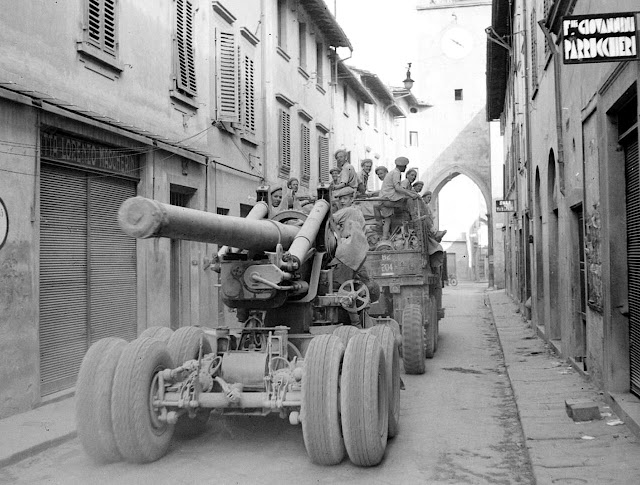 |
| 155mm Long Tom gun of 75th Heavy Regiment, Royal Artillery, being towed through Borgo San Lorenzo, Italy, 12 September 1944. font: IWM NA 18595 |
 |
| 155mm Long Tom gun of 33/61 Heavy Regiment Royal Artillery, at Vergato, 22 February 1945 font: IWM NA 22470 |
 |
| 155mm Long Tom gun being towed through a pontoon bridge over Durance River, France. 25, August. 1944. |
A small number of Long Tom guns were authorised for supply via Lend-Lease channels, to the United Kingdom (184) and France (25). The authorised establishment of British batteries (excluding training units), including four batteries from the Dominion of Newfoundland, totalled 88 guns.
Variants & types:
Gun variants:- M1920 - prototype.
- T4 - prototype.
- M1 (1938) - first production variant, 20 built.
- M1A1 (1941) - modified breech ring.M1A1E1 – prototype with chromium-plated bore.
- M1A1E3 - prototype with liquid cooling.
- M2 Standard (1945) - with modified breech ring.
- M59 - designation of M2 guns after WWII.
- T2 - prototype.
- M1 (1938).
- M1A1 - refurbished T2 carriages.
- M2 Standard
- M1 Standard (1938)
- M5 Heavy (1945)
The gun was also mounted on a modified M4 (HVSS) medium tank chassis, in mount M13. The resulting vehicle was initially designated 155 mm Gun Motor Carriage T83 and eventually standardized as 155 mm Gun Motor Carriage M40. A portable "Panama mount" M1 was also provided.
 |
| 155 mm Gun Motor Carriage M40 |
Firepower:
The Long Tom fires 155mm shells with a weight of around 45 kg at ranges up to 24 km. Under normal conditions, its sustained rate of fire is 40 rounds per hour, with an estimated accuracy life of 1.500 rounds. The types of ammunition that could be used included high-explosive, smoke, chemical, and illuminator projectiles.
 |
| 155mm shells |
Handling & Mobility:
The Long Tom 155mm was a big gun and difficult to transport in the field. During transport, the length is reduced by retracting the barrel onto the carriage.
Due to its weight and size, the Long Tom could not be deployed with human power alone. Its basement required trucks and/or artillery tractors. The preferable prime mover was initially the Mack NO 6×6 7½ ton truck; from 1943 on, it was supplemented by the tracked M4 High Speed Tractor.
 |
| Mack NO 6×6 7½ ton heavy truck |
 |
| M4 Artillery High Speed Tractor |
Almost 72 rounds of ammunition plus propelling charges could be carried in the M21 4-ton, 2-wheel ammunition trailer;
As well as 16 rounds of ammunition plus propelling charges could be carried in the M10 1-ton, 2-wheel ammunition trailer that was often used because of shortages of the former.
The later heavy M23 8-ton, 4-wheel ammunition trailer introduced in 1945 could carry 96 rounds of ammunition plus propelling charges.
Users:
The M59 was widely used by US forces during World War 2. After this conflict, it was also used in:
- Korean War
- Cambodian Civil War
- Croatian War of Independence
By that time it was supplemented by newer types of self-propelled heavy artillery. Many M59 were obtained as military aid by nations with good relations with the United States, such as:
- Italy
- Australia
- Greece
- Austria
- Japan
- Jordan
- South Korea
- Republic of China
- Turkey
- Pakistan
- Croatia
- South Africa
- United Kingdom
- Yugoslavia
- Netherlands
| M1 155 mm Long Tom | |
|---|---|
| Type | Towed field artillery |
| Place of origin | United States |
| Service history | |
| Used by | see text |
| Wars | see text |
| Production history | |
| Designed | 1918–1938 |
| Produced | 1940–1945 |
| No. built | 1,882 |
| Specifications | |
| Mass | Travel: 13,880 kg |
| Length | Travel: 13,71 m |
| Barrel length | 6.97 m - L/45 |
| Width | Travel: 2.43 m |
| Height | Travel: 3,04 m |
| Crew | 14 - 15 |
| Shell | Separate loading charge and projectile |
| Caliber | 155 mm |
| Breech | Asbury mechanism |
| Recoil | Hydro-pneumatic |
| Carriage | M1 Carriage |
| Elevation | −2°/+65° |
| Traverse | 60° |
| Rate of fire | 40 rounds per hour |
| Muzzle velocity | 853 m/s |
| Maximum firing range | 23.7 km |
The kit:
Well, for this project, I used the M59 155mm Long Tom gun, from AFV Club (#AF35009). This gun is the Korean version, a little ahead of the Historical Era that I like to build, but at the time I bought this kit, the WWII version of the AFV Club did not yet exist (M1A1 155mm Cannon "Long Tom" WWII version (# AF35295)).
 |
| Kojak and parts of the heavy gun, in the workbench... Notice the metal barrel, a big detail in the model... |
 |
| The AFV Club kit box art |
To make things easier, let's add a schematic drawing with the anatomy of a typical heavy gun (WWII era):
The kit, in general (when it comes to the AFV Club kits), is very well detailed and injected. As is usually the case, I try to follow the building steps in the instruction booklet...and in this case, it was the same... Starting the project by the barrel and breech...
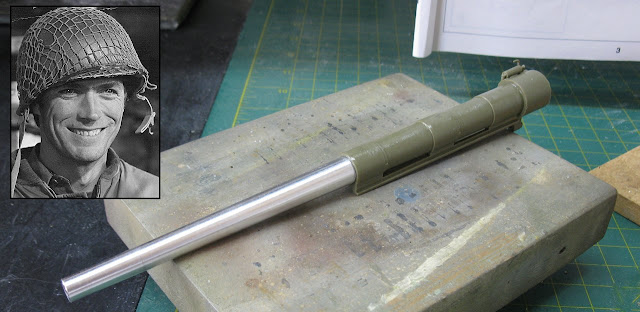 |
| Building the big cannon, starting by the tube and jacket. Private Kelly is very pleased!!! |
 |
| Starting the breech detailing... the thing promises to be fun... |
 |
| Private Kelly is loving it... Cradle in position!! |
 |
| Starting the trails...As the gun will be built in the trailer position, the spades will be installed on the sides of the trails, in his brackets... Notice the equilibrators in position. |
 |
| The carriage with trails in position... left view |
 |
| The carriage with trails in position... right view |
 |
| Alignment between the axes of the carriage's running system is fundamental... One mistake here and the weapon would be completely crooked!!! |
 |
| Adding the details of the cannon's undercarriage. Always respecting the alignment...Kojak is a meticulous guy!!! |
 |
| After some care, it's a pleasure to see everything lined up and perfect!!! |
 |
| Installing the undercarriage on the carriage of the weapon. The Long Tom starts to take shape!!! |
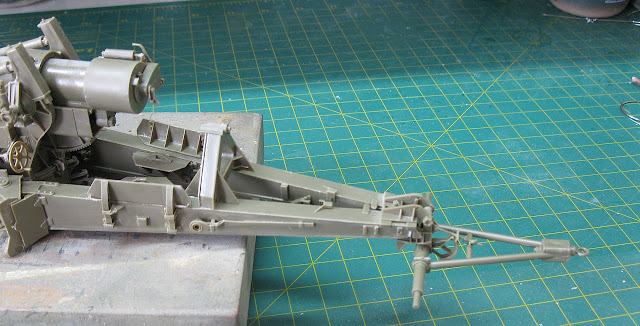 |
| Joining the two trails, in trailer position. Notice, right behind the spades, the big travel lock, joining the two trails. Notice the limber (A-frame) already installed at the ends of the trails. |
 |
| Wheels in position... |
 |
| The vinyl tires, from the kit... |
 |
| The elimination of the line of fusion (red arrow) with a Dremel sandpaper grinding wheel (blue arrows) Before and after! |
 |
| The Dremel sandpaper grinding wheel when sanding the surface, leaves the vinyl a bit "hairy"... |
 |
| To remove these hairs, let's use a Dremel Polishing Wheel... Before and after!! |
 |
| All the tires have a worn look, now... bald like Kojak's baby boy!!! |
 |
| Tires and wheels in position. This particular cannon has no markings at all... Just the standard Olive Drab paint. |
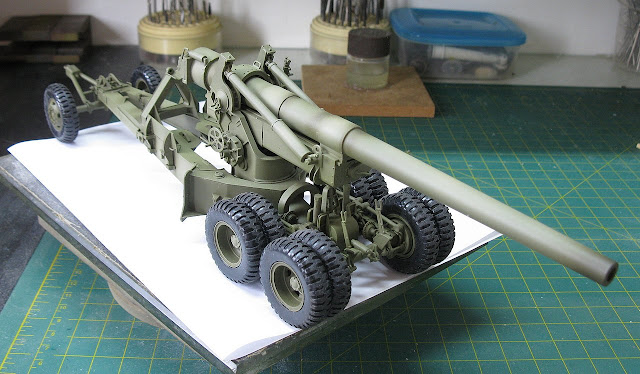 |
| 155mm heavy gun M59 Long Tom front right view |
 |
| 155mm heavy gun M59 Long Tom front left view |
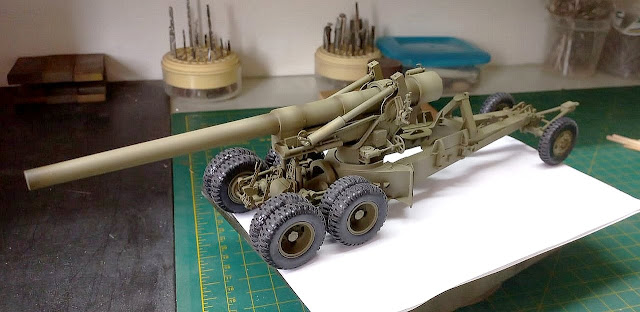 |
| Starting the weathering... 155mm heavy gun M59 Long Tom front left view |
 |
| Starting the weathering... 155mm heavy gun M59 Long Tom front right view |
 |
| Starting the wash... 155mm heavy gun M59 Long Tom front left view |
 |
| Starting the wash... 155mm heavy gun M59 Long Tom front right view |
 |
| Starting the wash... 155mm heavy gun M59 Long Tom left view |
 |
| Starting the wash... 155mm heavy gun M59 Long Tom rear left view |
 |
| Adding the powdered pigments... left view |
 |
| Adding the powdered pigments... right view |
And finally, I can call this (quick and simple) project finished. I really liked the look of this imposing piece of artillery. Really, it looks very showy in any militaria collection!! I decided to leave the barrel in an immediate firing position, not retreating the barrel to the travel locker, where the breech would be locked. This attitude would reproduce the weapon as if it were being transported a short distance to its new firing position. With the barrel in normal position in the cradle, the cannon's look is more harmonious. With you, the 155mm heavy gun M59 Long Tom: A true classic when it comes to tactical heavy artillery pieces...
 |
155mm heavy gun M59 Long Tom left view |
 |
155mm heavy gun M59 Long Tom right view |
 |
155mm heavy gun M59 Long Tom top right view |
 |
155mm heavy gun M59 Long Tom rear right view |
 |
155mm heavy gun M59 Long Tom rear left view |
 |
155mm heavy gun M59 Long Tom with Kojak and Rover, the dog!! |
 |
155mm heavy gun M59 Long Tom being towed by |
 |
| 155mm heavy gun M59 Long Tom |
 |
| 155mm heavy gun M59 Long Tom |
See you soon, Boys!!!













Great model as always Marcos! Bravo! What do you think about to buil another AFV gun: the 3 inch antitank gun M5 on carriage M6 (AFV 35181)? It is a real beauty and l have never undestood how to build the scope!
ResponderExcluirHi, Anonimous... Tthanks for your incentive...this 76,2mm AT gun is in my list of future projects, no doubt. Indeed, the profile of this legendary AT gun was much prettier with the carriage M6... A big hug and come back often!!!!
ExcluirA very beautiful model, inspiring to build, so thanks and good luck.. Roman from Prague
ResponderExcluirHI, Roman!!! Thanks for the visit and the kind words!!! Always come back here!!!
ExcluirSerra ... como sempre espetacular. Qual então a diferença desse kit que tenho (35009) , para o lançado mais tarde? Valeu... abs
ResponderExcluirOlá, Marcão. Muito obrigado !!! Sobre os kits, o lançado mais tarde, o de 2021, é a versão correta da WWII, o M1A1 155mm Cannon "Long Tom" WWII version, o kit 35295. O nosso kit (o Long Tom M59) faz a versão Coréia para frente. Vou te dar uma dica: dá uma olhada na Scalemates ( https://www.scalemates.com/ ), sobre o universo dos kits... Lá tem (quase) todos os kits do mercado, com sua linha temporal, inclusive...e com um plus de vc poder baixar os manuais de instruções dos kits. No caso específico de sua pergunta, o link seria esse: https://www.scalemates.com/kits/afv-club-af35295-m1a1-155mm-cannon-long-tom--1315926
ExcluirUm grande abraço e se cuida, Xará!!!
Vaaaaaleu bitcho... eu ja conhecia esse site.. esqueço de acessa-lo. Valeu pela ajuda... abração
ExcluirMi casa es tu casa, amigão!!! Se cuida e vamos potixar!!!
Excluir